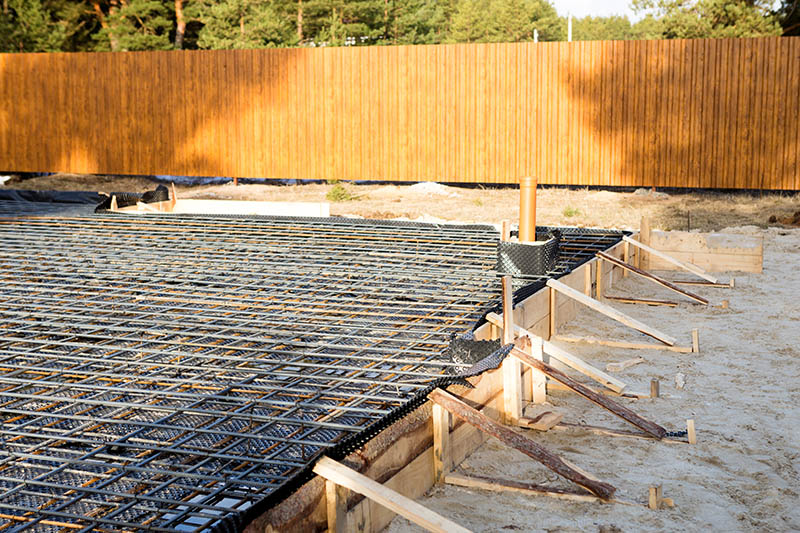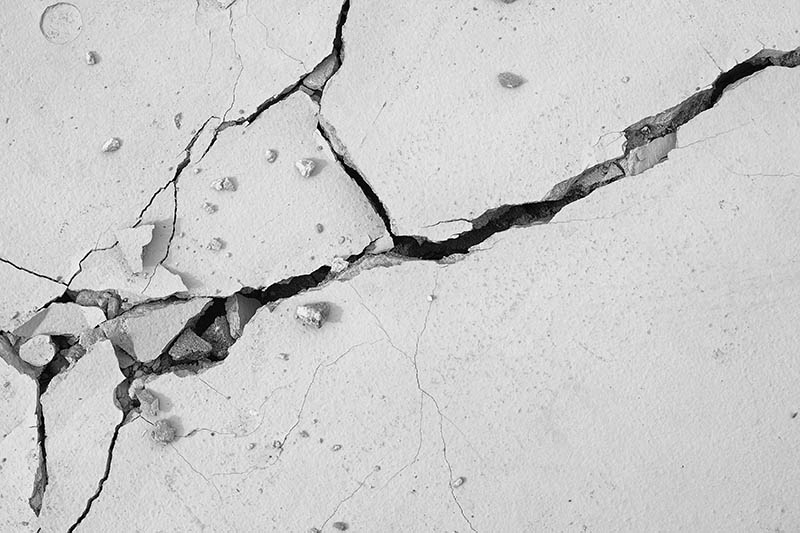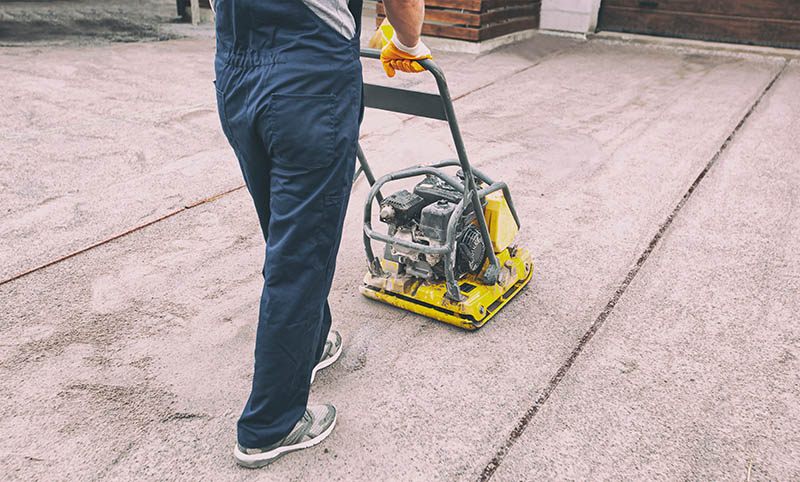What Type of Gravel Under Concrete Slab Is Best To Use?
-
Jeff Weishaupt
- Last updated:

When it comes to pouring concrete slabs, everyone goes about the job differently. You may think there’s no right or wrong way to do it but adding a layer of gravel beforehand is a recommended practice for pouring concrete slabs.
The gravel works as a foundation for the concrete slab, preventing settlement cracks and guaranteeing a level surface. It also ensures proper drainage by preventing water from pooling under the concrete.
The question is: what type of gravel are you supposed to use under a concrete slab? There are endless options, including pea gravel, crushed stone, white marble chips, and more. Keep reading to learn about what gravel to use under concrete.
What Type of Gravel Can You Use Under Concrete?
Depending on the concrete slab you want, you can choose between various types of gravel. That includes crushed stone, pea gravel, washed clean stones, white marble chips, and quarry process. Overall, crushed stone gravel is typically the most popular concrete base.
Most people use concrete slabs to build patios or driveways, so a fine aggregate and coarse gravel blend would be the perfect option. Additionally, combining stone dust with crushed stone creates the ideal base material for any concrete flatwork.
It’s important to consider the soil and ground you’ll be dealing with before you decide on a type of gravel. However, it isn’t as simple as picking the gravel type; you must also find the ideal gravel size and amount.

Gravel Type
When building concrete bases, most contractors opt for crushed stone gravel of varying sizes. Typically, the largest size of gravel used under concrete is 37 millimeters (mm). This material will help improve drainage and make it easy to apply concrete on top.
If an easy application is your priority, you should choose a blend of stone dust and crushed stone. However, the 1-inch washed and screened gravel is widely considered an all-rounder, also known as driveway gravel. Unwashed gravel may be covered in dust, causing the moisture content to wick upwards into the concrete slab and leading to structural issues.
Washed and screened gravel prevents this issue by eliminating water wicking. In addition, washing and screening your gravel removes smaller rocks, leaving only the ¾-inch gravel. Unfortunately, these smaller rocks also cause unnecessary water wicking.
Many assume crushed rock gravel is unsuitable for concrete slab foundations due to its jagged edges and rough composition. However, these sharp edges act as glue when compacted, creating a robust base.
On the other hand, people may recommend that mixing any gravel with old concrete works adequately for concrete bases. However, compacting and leveling such a mixture can be challenging, while the smaller rocks in the blend cause water-wicking issues.
Gravel Size
You can use two types of aggregates under a concrete slab: coarse aggregate and fine aggregate. While both are ideal options for concrete foundations, they come in varying sizes.
Coarse aggregate typically varies from 9.5mm to 38mm, while fine aggregate is always smaller than 9.5mm. Therefore, creating a perfect blend of large aggregates above 20mm can lead to the perfect concrete foundation.
It’s best to stay in the 20mm range when picking gravel, as gravel larger than 25mm is much harder to compact. Since it’s difficult to level large gravel, it’s hard to know how much you need for the perfect base.
Larger gravel can be too porous for certain concrete mixes, compromising the slab’s integrity. It’s also worth noting that these rocks can break through and impede the installation if you place foam between the gravel and concrete.

Gravel Amount
The amount of gravel you use depends on how thick the concrete slab will be. For example, if the slab is 4 inches thick, you’ll need a gravel foundation of 3 inches. Of course, we recommend adding more gravel, but it should be no less than 3 inches.
In such cases, using ¾-inch washed and screen gravel is best. Since this gravel is easy to compact and level, estimating the required amount is never difficult. Adding more gravel is always a great idea, but you must remember to compact it every 5 inches. This is crucial to keep in mind if you have a plate compactor.
You must also remember that the foam doesn’t interfere with the concrete or gravel’s thickness if you use rigid foam boards between the two layers. For example, if you use a 2-inch foam board, the gravel layer must still be 3 inches thick for a 4-inch concrete slab.
Why Do You Need Gravel Under a Concrete Slab?
Adding a gravel foundation may seem unnecessary, considering the strength of concrete. However, this process is crucial for maintaining the structural integrity of the concrete slab. Here’s why you need to use gravel under a concrete slab:
Prevent Settlement Cracks
Failing to prepare the underlying ground for the concrete mixture can lead to settlement cracks in the long run. In addition, this flaw can cause unevenness and other structural issues.
Poorly compacted soil and movement in the ground are the main reasons behind such cracks. Luckily, a robust, crushed stone foundation can reduce such movement and help prevent settlement cracks in your concrete slab.

Ensure Proper Drainage
Concrete is highly porous, with 12%–18% of the slab consisting of pores. As a result, your concrete slab will absorb all moisture it comes in contact with, leading to pooling. This will cause water to settle under your concrete slab, eroding over time.
A crushed stone foundation ensures proper drainage by creating a barrier between the ground and the concrete slab. In addition, incorporating a vapor barrier is a great way to further protect the concrete from moisture.
Create a Level Surface
Lastly, a gravel foundation ensures a level surface while pouring the concrete mixture. If you pour the concrete mixture directly onto the ground, elemental erosion will crack and sink the concrete slab, leading to unevenness.
The concrete slab may also crush plants or roots under it, resulting in evenness once they rot. Gravel works as the perfect barrier between the concrete and the ground and prevents issues related to elemental erosion and rotting plants.
 FAQs – Best Gravel To Use Under Concrete Slabs
FAQs – Best Gravel To Use Under Concrete Slabs
Here’s everything to know about using gravel under concrete slabs.
How Do You Compact Gravel for Concrete?
A jumping jack or plate compactor will always serve better than a manual solution, such as a hand tamper, while compacting a gravel foundation for your concrete slab. If you plan on adding more gravel than 3 inches, we recommend compacting it every 5 inches.
You may rent a plate compactor by the hour if you want to do the job without a contractor. Then, depending on the thickness of your concrete, you can finish up within a few hours. However, using a hand tamper may lengthen the task unnecessarily.

Can You Use Dirt Under a Concrete Slab?
While it isn’t recommended, you can pour your concrete mixture directly over dirt. It’s best if your soil type is compact, such as solid clay soil, which may provide enough support for the concrete slab.
However, pouring concrete over dirt can lead to pooling and structural issues, which you can avoid with the help of a vapor barrier. Of course, it won’t eliminate pooling entirely, but the solid clay soil may resist erosion better than a sandy type.
While a vapor barrier is a great solution, a gravel foundation always works better when ensuring proper drainage. A soil foundation may work adequately for sheds and barns but can cause moisture issues in commercial buildings.
Undoubtedly, pouring concrete over dirt is more affordable and time-saving than a gravel foundation. But the concrete slab is likelier to develop cracks and deteriorate quicker.
Do You Need a Vapor Barrier Between Concrete and Gravel?
A vapor barrier helps prevent moisture wicking, which causes wet spots, foul odors, and structural issues in the concrete slab. Moisture wicking can also lead to rot, mildew, or mold growing between the concrete and the flooring.
Putting a vapor barrier is never a bad idea, but you must remember to place it directly below the concrete slab. This barrier will ensure the water never enters the slab, draining the gravel. It also keeps your rigid foam moisture-free, protecting the insulation’s saturation.
Conclusion
Pouring a concrete slab is no easy feat, which is why you must ensure your effort lasts for decades. A gravel foundation is a crucial step during this process, which can lead to premature structural issues if skipped.
Using the right type, size, and amount of gravel under your concrete slab can ensure proper drainage, guarantee a level surface, and prevent settlement cracks in the long run.
Featured Image Credit: Simol1407, Shutterstock
Contents

 FAQs – Best Gravel To Use Under Concrete Slabs
FAQs – Best Gravel To Use Under Concrete Slabs